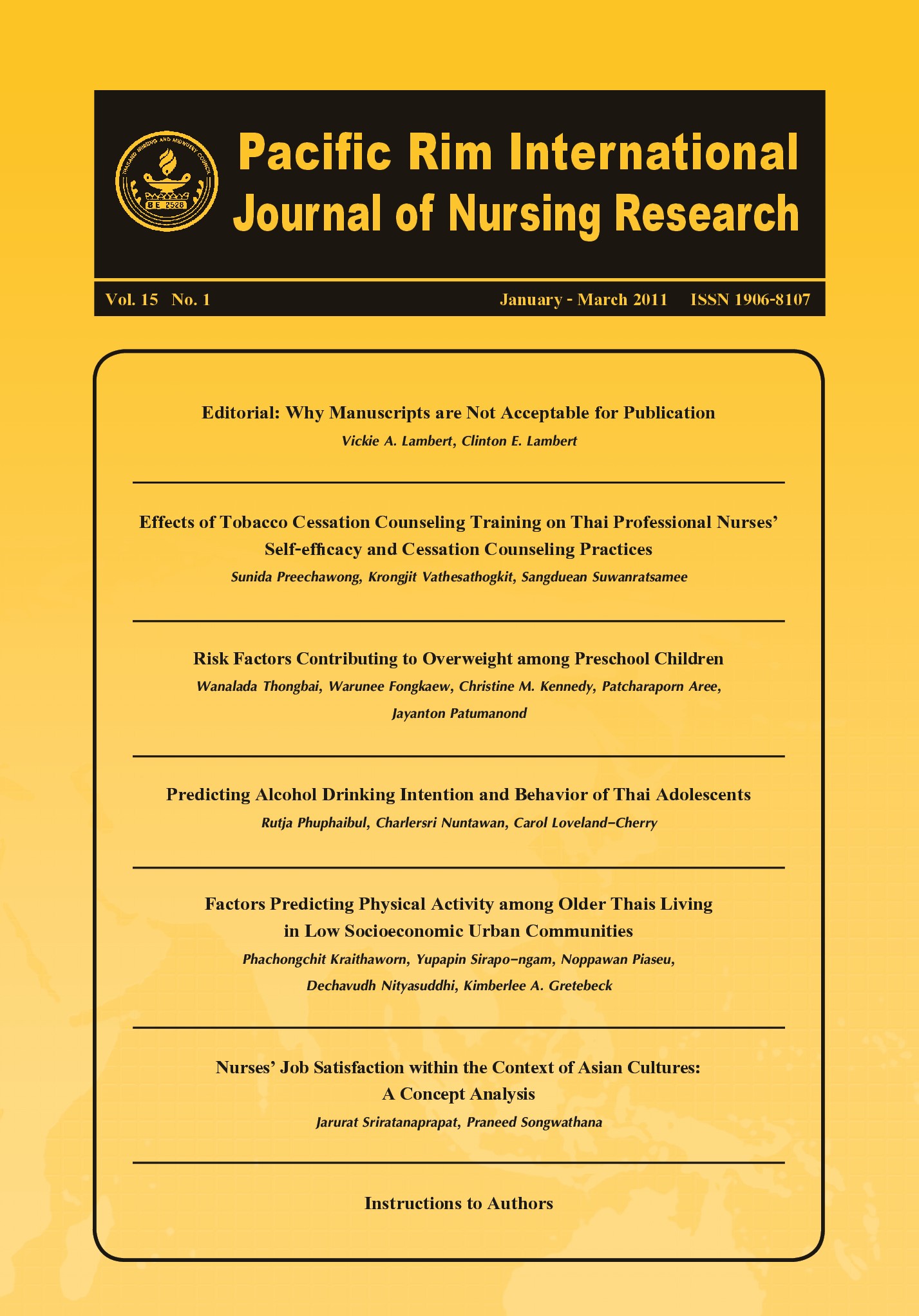Factors Predicting Physical Activity among Older Thais Living in Low Socioeconomic Urban Communities
Keywords:
Physical activity, Older Thais, Low-socioeconomicAbstract
บทคัดย่อ
การวิจัยนี้มีวัตถุประสงค์เพื่อศึกษาความสัมพันธ์เชิงสาเหตุของ การรับรู้สมรรถนะในตน ด้านการทำกิจกรรมการเคลื่อนไหวออกแรง ความรู้สึกเป็นส่วนหนึ่งของชุมชน การสนับสนุนทางสังคม การรับรู้สุขภาพกาย การรับรู้สุขภาพจิต และ การรับรู้สภาพสิ่งแวดล้อมละแวกบ้าน ต่อการทำกิจกรรม การเคลื่อนไหวออกแรงของผู้สูงอายุไทย จำนวน 258 คนที่อาศัยอยู่ในชุมชนแออัด จำนวน 6 ชุมชน ในกรุงเทพมหานคร โดยผสมผสานแนวคิดการส่งเสริมสุขภาพของเพนเดอร์ และแนวคิดเชิงนิเวศน์วิทยา วิเคราะห์โมเดลด้วยการวิเคราะห์อิทธิพล
ผลการศึกษา พบว่า แบบจำลองสุดท้ายทำนายความผันแปรของการทำกิจกรรมการเคลื่อนไหว ออกแรง การรับรู้สมรรถนะในตน และความรู้สึกเป็นส่วนหนึ่งของชุมชนได้ 33%, 51% และ 22% ตามลำดับ การรับรู้สมรรถนะในตนทำนายการทำกิจกรรมการเคลื่อนไหวออกแรงได้ดีที่สุด ความรู้สึก เป็นส่วนหนึ่งของชุมชน และการรับรู้สุขภาพกายมีอิทธิพลโดยตรงทางบวกต่อการทำกิจกรรมการ เคลื่อนไหวออกแรง และมีอิทธิพลโดยอ้อมทางบวกต่อการทำกิจกรรมการเคลื่อนไหวออกแรงผ่านการ รับรู้สมรรถนะในตน การรับรู้สุขภาพจิตมีอิทธิพลโดยอ้อมทางลบต่อการทำกิจกรรมการเคลื่อนไหว ออกแรง ผ่านการรับรู้สมรรถนะในตน แต่มีอิทธิพลโดยตรงทางบวกต่อการทำกิจกรรมการเคลื่อนไหว ออกแรง แม้ว่าการสนับสนุนทางสังคม และการรับรู้สภาพสิ่งแวดล้อมละแวกบ้านไม่มีผลโดยตรงต่อ การทำกิจกรรมการเคลื่อนไหวออกแรง แต่การสนับสนุนทางสังคมมีอิทธิพลโดยอ้อมทางบวกต่อการ ทำกิจกรรมการเคลื่อนไหวออกแรงผ่านความรู้สึกเป็นส่วนหนึ่งของชุมชน ส่วนการรับรู้สภาพสิ่งแวดล้อม ละแวกบ้านมีอิทธิพลโดยอ้อมทางบวกต่อการทำกิจกรรมการเคลื่อนไหวออกแรง ผ่านความรู้สึกเป็น ส่วนหนึ่งของชุมชน และการรับรู้สมรรถนะในตน
ผลการศึกษาครั้งนี้ทำให้สามารถเข้าใจถึงปัจจัยที่มีอิทธิพลต่อการทำกิจกรรมการเคลื่อนไหว ออกแรง ของผู้สูงอายุที่อาศัยอยู่ในชุมชนแออัด เขตเมือง และสามารถนำไปสู่การพัฒนาโปรแกรม และหรือ คู่มือในการส่งเสริมการทำกิจกรรมทางการเคลื่อนไหวออกแรงที่มีประสิทธิภาพ และเหมาะสม กับบริบทของผู้สูงอายุไทย ต่อไป
คำสำคัญ : กิจกรรมการเคลื่อนไหวออกแรง ผู้สูงอายุไทย ชุมชนแออัด เขตเมือง ความรู้สึกเป็นส่วนหนึ่ง ของชุมชน การรับรู้สมรรถนะในตนด้านการเคลื่อนไหวออกแรง
Abstract
This study was conducted to determine if specific factors (physical activity self-efficacy, sense of community, social support, perceived physical and mental health, and neighborhood environment and facilities) predicted physical activity among 258 older Thais living in six registered, low-socioeconomic, urban communities across metropolitan Bangkok. The theoretical model was based on integrated concepts from Pender’s Health Promotion Model and the Social Ecological Model. The hypothesized model was tested using path analysis.
The final model explained 33%, 51% and 22% of the variance in physical activity, physical activity self-efficacy and sense of community, respectively. Physical activity self-efficacy was the most powerful predictor in explaining physical activity. Sense of community and perceived physical health had a positive direct effect and a positive indirect effect, through physical activity self-efficacy, on physical activity. Perceived mental health had a negative indirect effect on physical activity, through physical activity self-efficacy, but a positive direct effect on physical activity. Social support, as well as neighborhood environment and facilities, did not significantly predict physical activity. However, social support had a positive indirect effect on physical activity through sense of community. Neighborhood environment and facilities had a positive indirect effect on physical activity through sense of community and physical activity self- efficacy.
These findings provide a greater understanding of factors that predict physical activity among older Thais living in low-socioeconomic urban communities across metropolitan Bangkok. The results may be useful in the development of effective interventions and/or guidelines for promoting physical activity for older Thais.
Keywords : Physical activity, Older Thais, Low-socioeconomic
Downloads
How to Cite
Issue
Section
License
Copyright: The Pacific Rim International Journal of Nursing Research, Thailand Nursing & Midwifery Council has exclusive rights to publish, reproduce and distribute the manuscript and all contents therein.







.png)


